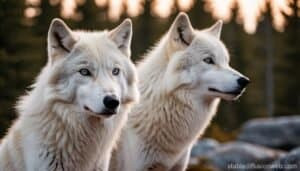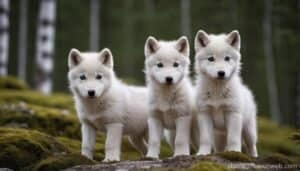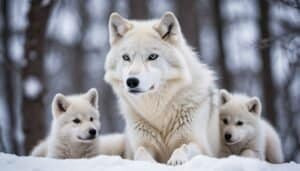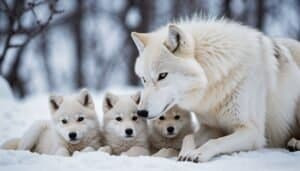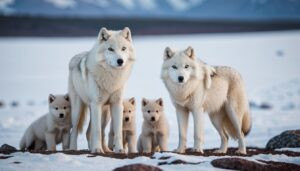Introduction
The reproductive hormones of Arctic wolves play a crucial role in regulating their mating, pregnancy, and nurturing behaviors. These hormones ensure the survival and continuity of the species in the harsh Arctic environment
This article delves into the primary reproductive hormones, their changes during pregnancy and nurturing, and the influence of environmental and social factors on hormonal regulation
Additionally, we will explore the hormonal dynamics between alpha pairs and subordinate wolves, providing a comprehensive understanding of Arctic wolf reproduction
The Basics of Reproductive Hormones in Arctic Wolves
Arctic wolves, like other canids, have a complex hormonal system that regulates their reproductive functions. Understanding these hormones and their roles provides insights into the mating behaviors, pregnancy, and nurturing of these resilient animals
This section will cover the primary reproductive hormones, the estrus cycle, and the role of testosterone in mating behavior
Primary Reproductive Hormones
The primary reproductive hormones in Arctic wolves are estrogen, progesterone, and testosterone. Each of these hormones has specific functions and phases of activity that are crucial for the reproductive cycle:
Estrogen: This hormone is primarily responsible for regulating the estrus cycle in female Arctic wolves. It triggers the physical and behavioral changes necessary for mating. High levels of estrogen are present during the estrus, or heat, period, signaling that the female is ready to mate
Progesterone: After mating, progesterone becomes the dominant hormone. It is essential for maintaining pregnancy. Elevated levels of progesterone support the development of the uterine lining and prevent further estrus cycles, ensuring that the female can carry the pregnancy to term
Testosterone: In males, testosterone is crucial for the development of secondary sexual characteristics and mating behavior. It increases during the breeding season, leading to heightened aggression and territoriality, which are necessary for competing with other males and securing mates
Estrus Cycle Function
The estrus cycle in Arctic wolves is influenced by various factors, including photoperiod (the length of day and night), social structure, and environmental conditions. Typically, Arctic wolves breed once a year, with the estrus cycle occurring in late winter to early spring
During the estrus cycle, estrogen levels rise, causing the female to exhibit behaviors and physical signs that indicate she is in heat. These signs include increased vocalizations, scent marking, and a more pronounced vulva. The cycle lasts for several days, during which the female is receptive to mating
Testosterone and Mating Behavior
Testosterone plays a significant role in the mating behavior of male Arctic wolves. During the breeding season, testosterone levels increase, leading to more pronounced displays of dominance and aggression. Males become more territorial and are more likely to engage in fights with other males to establish dominance and secure mating opportunities
High testosterone levels also influence physical changes, such as an increase in muscle mass and the development of a thicker neck, which are advantageous in confrontations with rival males
Additionally, testosterone affects the olfactory system, enhancing the male’s ability to detect pheromones released by females in estrus, thus facilitating successful mating
Understanding the roles of these primary reproductive hormones in Arctic wolves provides a foundation for exploring the hormonal changes that occur during pregnancy and the nurturing of pups
These hormones not only regulate the physical aspects of reproduction but also influence the complex behaviors necessary for the survival and continuity of the species in the Arctic’s challenging environment
Hormonal Changes During Pregnancy and Nurturing
Reproductive hormones continue to play a crucial role in the Arctic wolf’s life after mating, particularly during pregnancy and the nurturing of pups
This section will explore the hormonal changes that occur during pregnancy, how these hormones influence nurturing behavior, and the role of hormones in the lactation process
Pregnancy Hormones
Once mating has occurred, the Arctic wolf’s body undergoes significant hormonal changes to support pregnancy
Progesterone, a key hormone during this period, increases substantially to maintain the pregnancy. This hormone prevents the female from entering another estrus cycle and supports the development of the uterine lining, which is essential for the implantation and growth of embryos
Progesterone also has a calming effect on the female, reducing stress and promoting behaviors that protect the developing pups. Throughout the pregnancy, which lasts approximately 63 days, progesterone levels remain high to ensure that the uterine environment is optimal for fetal development
As the pregnancy progresses, other hormones, such as relaxin, increase to help prepare the female’s body for labor and delivery
Hormonal Influence on Nurturing Behavior
Hormones also significantly influence the nurturing behavior of Arctic wolf mothers. Oxytocin, often referred to as the “bonding hormone,” plays a critical role in mother-pup bonding and nurturing behaviors. Released during labor, oxytocin helps to facilitate contractions and later promotes milk ejection during nursing
The high levels of oxytocin continue to affect the mother’s behavior, making her more attentive and protective towards her pups. This hormone encourages the mother to engage in licking, grooming, and close physical contact with her pups, which are essential for their survival and well-being
The nurturing behaviors induced by oxytocin help to establish a strong bond between the mother and her pups, ensuring that they receive the care and protection they need during their early, vulnerable stages of life
Lactation Process Hormones
Lactation is another critical period influenced by hormones in Arctic wolves
Prolactin, a hormone released by the pituitary gland, is primarily responsible for milk production. After the birth of the pups, prolactin levels increase to stimulate the mammary glands to produce milk. This hormone ensures that the pups have a consistent supply of nutrition necessary for their growth and development
Prolactin also supports maternal behaviors, reinforcing the mother’s dedication to feeding and caring for her pups. The combination of high prolactin and oxytocin levels ensures that the mother remains focused on nurturing her young, providing both the nutritional and emotional support needed for their survival
These hormonal changes and their effects on behavior highlight the complex and crucial role of reproductive hormones during the pregnancy and nurturing phases of Arctic wolves
Understanding these processes provides valuable insights into the reproductive success and survival strategies of these animals in their harsh Arctic environment
Environmental and Social Influences on Hormonal Regulation
The reproductive hormones of Arctic wolves are not only influenced by internal physiological processes but also by external environmental and social factors. This section will explore how seasonal changes, environmental factors, and stress impact the hormonal regulation in Arctic wolves
Seasonal Changes and Hormones
The extreme seasonal variations in the Arctic significantly affect the reproductive hormones of Arctic wolves. The lengthening and shortening of daylight hours, known as photoperiodism, play a crucial role in regulating the reproductive cycle
During the winter months, the decreasing daylight triggers hormonal changes that prepare wolves for the breeding season. Melatonin, a hormone produced in response to darkness, influences the production of gonadotropin-releasing hormone (GnRH) in the brain
GnRH stimulates the release of luteinizing hormone (LH) and follicle-stimulating hormone (FSH), which are essential for the development of reproductive organs and the onset of estrus in females and spermatogenesis in males
As spring approaches and daylight increases, these hormonal changes culminate in the breeding season. The synchronized timing ensures that pups are born during the warmer months when food is more abundant and conditions are more favorable for their survival
Impact of Environmental Factors
Environmental factors such as food availability, habitat conditions, and climate also play a significant role in hormonal regulation
Arctic wolves rely heavily on the availability of prey, such as caribou and musk oxen, to meet their nutritional needs. A plentiful food supply can enhance reproductive success by ensuring that females have the necessary energy reserves to support pregnancy and lactation
In contrast, scarce food resources can lead to nutritional stress, which negatively impacts reproductive hormones. For instance, malnutrition can lower estrogen levels, leading to irregular estrus cycles or even anestrus (a period of reproductive inactivity)
Similarly, low body condition can reduce progesterone levels, increasing the risk of pregnancy loss or poor pup survival
Climate changes, including rising temperatures and altered precipitation patterns, can also affect the availability of prey and the condition of the habitat. These environmental stresses can further influence hormonal regulation and reproductive success in Arctic wolves
Stress Effects on Hormones
Stress is another critical factor that impacts the reproductive hormones of Arctic wolves. Stressful situations, such as conflicts within the pack, human disturbances, or extreme weather conditions, can lead to elevated levels of cortisol, the primary stress hormone
High cortisol levels can disrupt the balance of reproductive hormones. For example, chronic stress can suppress the release of GnRH, leading to lower levels of LH and FSH, and subsequently reducing fertility
In females, high cortisol levels can interfere with the estrus cycle, inhibit ovulation, and reduce progesterone levels, compromising pregnancy maintenance. In males, elevated cortisol can lower testosterone levels, affecting sperm production and mating behaviors
The ability of Arctic wolves to adapt to and manage stress is crucial for their reproductive success. Pack dynamics, social hierarchies, and supportive behaviors within the pack can help mitigate stress and promote hormonal balance
Understanding how environmental and social factors influence the reproductive hormones of Arctic wolves is essential for conservation efforts. By recognizing the interconnectedness of these factors, we can better support the survival and reproductive success of these remarkable animals in their changing environment
Alpha Pair vs. Subordinate Wolves: Hormonal Dynamics
The social structure of Arctic wolf packs profoundly affects the reproductive hormones and behaviors of individual wolves. In these packs, only the alpha pair typically breeds, while subordinate wolves do not
This section will explore the hormonal regulation in alpha pairs, pack breeding dynamics, and the differences in hormone levels between wild and captive Arctic wolves
Hormonal Regulation in Alpha Pairs
In Arctic wolf packs, the alpha pair—the dominant male and female—maintains exclusive breeding rights. This dominance is closely linked to their hormonal profiles, which are optimized for reproduction:
Alpha Females: The alpha female exhibits higher levels of estrogen and progesterone compared to subordinate females. During the breeding season, her estrogen levels rise, triggering estrus and making her receptive to mating
Following mating, her progesterone levels increase to support pregnancy. The elevated levels of these hormones are partly maintained by the social dynamics of the pack, which reinforce her dominant status and reduce stress
Alpha Males: The alpha male has higher testosterone levels than subordinate males. This hormone peaks during the breeding season, enhancing his sexual drive, aggression, and territorial behavior
High testosterone levels ensure that the alpha male is ready to mate and can defend his position from rival males. This dominance is crucial for maintaining the stability of the pack’s breeding structure
Pack Breeding and Hormonal Interactions
The breeding dynamics within the pack are influenced by the interplay of hormonal signals and social behaviors. Subordinate wolves, both male and female, generally do not breed, a phenomenon regulated by both hormonal and behavioral mechanisms:
Subordinate Females: These females experience lower levels of reproductive hormones due to social suppression by the alpha female
The presence of the alpha female and her pheromonal signals can inhibit the reproductive cycles of subordinate females, preventing them from entering estrus. This social suppression ensures that the alpha female’s pups receive the undivided attention and resources of the pack
Subordinate Males: Similarly, subordinate males have lower testosterone levels compared to the alpha male
The social hierarchy and interactions within the pack suppress their reproductive hormones, reducing their drive to mate and keeping them in a supportive, non-breeding role. These males often help with hunting and caring for the alpha pair’s pups, which increases the overall survival of the pack
Hormone Differences in Wild vs. Captive Wolves
The hormonal dynamics of Arctic wolves can differ significantly between wild and captive environments. Captive wolves often face different stressors and environmental conditions that can influence their hormone levels and reproductive behaviors:
Wild Wolves: In the wild, the natural social structure and environmental challenges help regulate hormonal levels and reproductive behaviors
Wild wolves experience seasonal variations, natural prey availability, and the social dynamics of a pack, all of which contribute to their hormonal regulation. These factors ensure that only the fittest individuals breed, maintaining the health and genetic diversity of the population
Captive Wolves: Captivity can alter the hormonal dynamics of Arctic wolves due to changes in diet, space, social structure, and stress levels. Captive wolves may not experience the same seasonal cues or social interactions that regulate their reproductive hormones in the wild
For instance, the absence of natural stressors and the availability of constant food supplies can lead to changes in the timing and levels of reproductive hormones. Additionally, the artificial social structures in captivity can affect breeding behaviors, sometimes leading to higher instances of subordinate wolves attempting to breed
Understanding the differences in hormonal dynamics between wild and captive Arctic wolves is essential for effective management and conservation strategies. Ensuring that captive environments simulate natural conditions as closely as possible can help maintain the health and reproductive success of these wolves
This comprehensive examination of hormonal dynamics within the social hierarchy of Arctic wolf packs highlights the complex interplay between biology and behavior in these fascinating animals
Conclusion
The reproductive hormones of Arctic wolves are vital in regulating their complex reproductive behaviors and ensuring the survival of the species in the harsh Arctic environment. These hormones play crucial roles in various stages of the reproductive cycle, from mating and pregnancy to the nurturing of pups
Understanding the basics of reproductive hormones, such as estrogen, progesterone, and testosterone, provides insight into how these hormones influence mating behaviors and the estrus cycle
During pregnancy, hormonal changes are essential for maintaining pregnancy and preparing the female for the birth and nurturing of pups. Hormones like oxytocin and prolactin significantly impact nurturing behaviors and milk production, ensuring that the pups receive the necessary care and nutrition for their development
Environmental and social factors also significantly affect the hormonal regulation in Arctic wolves. Seasonal changes, food availability, habitat conditions, and stress levels can influence reproductive hormones, impacting the wolves’ reproductive success
The social structure of the pack, particularly the dominance of the alpha pair, regulates the breeding rights and hormonal levels of individual wolves, ensuring the stability and survival of the pack
Differences in hormonal dynamics between wild and captive Arctic wolves highlight the importance of maintaining natural conditions in captivity to support their health and reproductive success. By understanding these complex hormonal interactions, we can better support the conservation and management of Arctic wolves, ensuring their continued survival in a changing environment
This comprehensive overview underscores the intricate balance between biology, environment, and social structure in the reproductive success of Arctic wolves, providing valuable insights for conservation efforts



